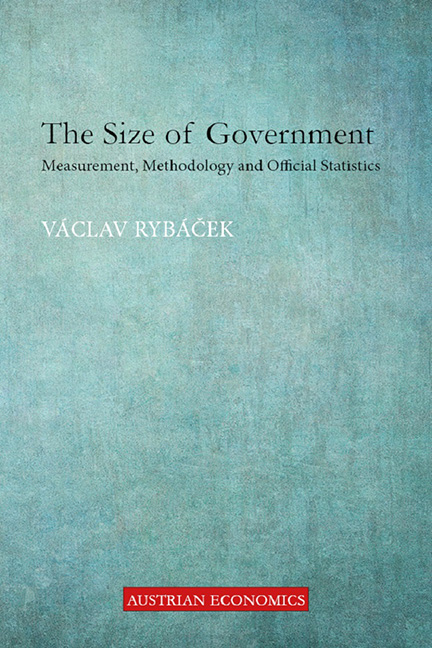Book contents
- Frontmatter
- Contents
- Introduction
- Chapter 1 The Size of Government in Economics
- Chapter 2 The Role of Measuring Government in Economic Policy
- Chapter 3 A Short Trip to the Past
- Chapter 4 The Current Approach
- Chapter 5 What’s Wrong with the Current Approach?
- Chapter 6 The Size of Government and GDP
- Chapter 7 Is the Size of Government Underestimated?
- Chapter 8 Recalculation of the Size of Government
- Conclusion
- Notes
- Bibliography
- Index
Introduction
Published online by Cambridge University Press: 09 August 2023
- Frontmatter
- Contents
- Introduction
- Chapter 1 The Size of Government in Economics
- Chapter 2 The Role of Measuring Government in Economic Policy
- Chapter 3 A Short Trip to the Past
- Chapter 4 The Current Approach
- Chapter 5 What’s Wrong with the Current Approach?
- Chapter 6 The Size of Government and GDP
- Chapter 7 Is the Size of Government Underestimated?
- Chapter 8 Recalculation of the Size of Government
- Conclusion
- Notes
- Bibliography
- Index
Summary
“Everyone knows that government has grown, but no one knows exactly how much.”
Robert HiggsIn 2016, the debt of Germany stood at 68.3 per cent of GDP with a downward trend. Among highly indebted European countries, Germany was considered one of the finest. However, what if we said that the debt of Germany stood actually at 314.9 per cent, with an upward trend? Would that be insanity? Not necessarily. Statistical reality is only a matter of statistical methodology and statistical theory. We, as data-users with critical thinking, should always ask ourselves a simple question to begin with: how can statisticians know that? We shall keep asking throughout this book: what methodology stands behind those figures? What are its weaknesses? And ultimately, are we really getting the information that we expected?
Questions of this kind might be asked in any statistical area. As Morgenstern (1963) rightly pointed out, statistical observations are deliberately designed, guided by constructed statistical theories which make macroeconomic aggregates graspable, but with aggregation comes costs. Errors of observations, calculation errors, misreporting and many other factors can introduce high uncertainty into final figures and their explanatory power. However, this typically remains hidden from data-users who get little idea of what degree of uncertainty is inherent in the final aggregates.
Let’s suppose that the most recent rate of GDP growth released by statisticians reached 2 per cent annually. During its calculation and the balancing process, a certain discrepancy between production and expenditure inevitably occurred. Statisticians then pick a method of how best to reconcile both sides of the balance. The final growth rate depends, of course, on their decision. They can increase total expenditure or to lower production, or vice versa, in all cases influencing the annual growth rate. It is entirely conceivable that the range of potential results obtained can vary from zero to 4 per cent growth. Therefore, we could have concluded that economic growth had come to a standstill, but we could have equally well concluded that we are experiencing solid economic growth.
- Type
- Chapter
- Information
- The Size of GovernmentMeasurement, Methodology and Official Statistics, pp. 1 - 6Publisher: Agenda PublishingPrint publication year: 2019



